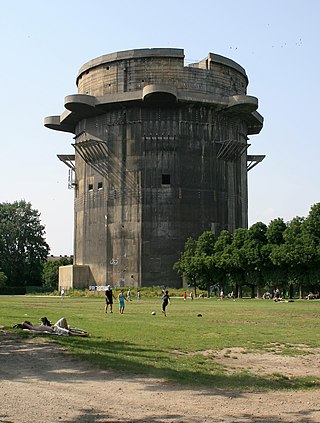
A bunker is a defensive military fortification designed to protect people and valued materials from falling bombs, artillery, or other attacks. Bunkers are almost always underground, in contrast to blockhouses which are mostly above ground. They were used extensively in World War I, World War II, and the Cold War for weapons facilities, command and control centers, and storage facilities. Bunkers can also be used as protection from tornadoes.

The Atlantic Wall was an extensive system of coastal defences and fortifications built by Nazi Germany between 1942 and 1944 along the coast of continental Europe and Scandinavia as a defence against an anticipated Allied invasion of Nazi-occupied Europe from the United Kingdom, during World War II. The manning and operation of the Atlantic Wall was administratively overseen by the German Army, with some support from Luftwaffe ground forces. The Kriegsmarine maintained a separate coastal defence network, organised into a number of sea defence zones.

A fortification is a military construction designed for the defense of territories in warfare, and is used to establish rule in a region during peacetime. The term is derived from Latin fortis ("strong") and facere.

The Siegfried Line, known in German as the Westwall, was a German defensive line built during the 1930s opposite the French Maginot Line. It stretched more than 630 km (390 mi) from Kleve on the border with the Netherlands, along the western border of Nazi Germany, to the town of Weil am Rhein on the border with Switzerland. The line featured more than 18,000 bunkers, tunnels and tank traps.
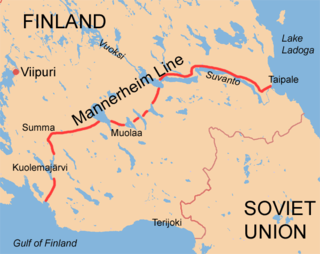
The Mannerheim Line was a defensive fortification line on the Karelian Isthmus built by Finland against the Soviet Union. While this was never an officially designated name, during the Winter War it became known as the Mannerheim Line, after Finnish Army's then commander-in-chief Field Marshal Baron Carl Gustaf Emil Mannerheim. The line was constructed in two phases: 1920–1924 and 1932–1939. By November 1939, when the Winter War began, the line was by no means complete.
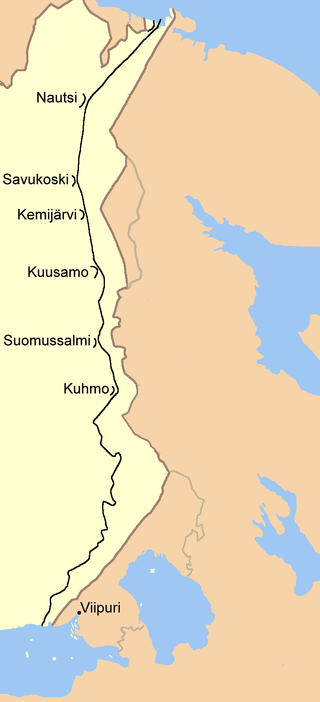
The Salpa Line, or its official name, Suomen Salpa, is a bunker line on the eastern border of Finland. It was built in 1940–1941 during the Interim Peace between the Winter War and the Continuation War and further in 1944 to defend Finland against a possible Soviet invasion.

A blockhouse is a small fortification, usually consisting of one or more rooms with loopholes, allowing its defenders to fire in various directions. It is usually an isolated fort in the form of a single building, serving as a defensive strong point against any enemy that does not possess siege equipment or, in modern times, artillery, air force and cruise missiles. A fortification intended to resist these weapons is more likely to qualify as a fortress or a redoubt, or in modern times, be an underground bunker. However, a blockhouse may also refer to a room within a larger fortification, usually a battery or redoubt.
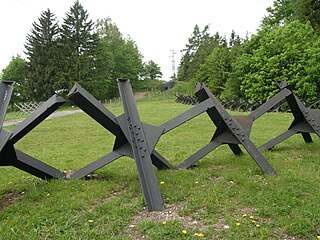
The Czech hedgehog is a static anti-tank obstacle defense made of metal angle beams or I-beams. It is similar in shape to a much larger version of metal knucklebones or caltrops. The hedgehog is very effective in keeping light to medium tanks and vehicles from penetrating a line of defense; it maintains its function even when tipped over by a nearby explosion. Although Czech hedgehogs may provide some scant cover for attacking infantry, infantry forces are generally much less effective against fortified defensive positions than mechanized units.
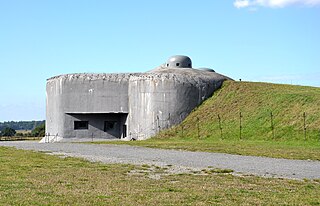
The Hlučín-Darkovičky Czechoslovak Fortification Complex is an exhibition of 1930's military fortifications in Hlučín-Darkovičky, Czech Republic.

The Koningshooikt–Wavre Line, abbreviated to KW Line and often known as the Dyle Line after the Dijle (Dyle) river, was a 60 kilometres (37 mi)-long fortified line of defence prepared by the Belgian Army between Koningshooikt and Wavre which was intended to protect Brussels from a possible German invasion. Construction on the KW Line began in September 1939 after World War II had begun but while Belgium itself remained a neutral state. It was subsequently extended southwards from Wavre towards Namur. The line itself consisted of bunkers, anti-tank ditches, and barricades including so-called Cointet-elements and played a key role in Allied strategy during the German invasion of Belgium in May 1940. However, its role in the actual fighting was ultimately minimal. In 2009 an inventory of surviving emplacements was begun.

British hardened field defences of World War II were small fortified structures constructed as a part of British anti-invasion preparations. They were popularly known as pillboxes, a reference to their shape.
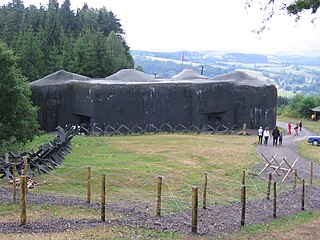
Czechoslovakia built a system of border fortifications as well as some fortified defensive lines inland, from 1935 to 1938 as a defensive countermeasure against the rising threat of Nazi Germany. The objective of the fortifications was to prevent the taking of key areas by an enemy—not only Germany but also Hungary and Poland—by means of a sudden attack before the mobilization of the Czechoslovak Army could be completed, and to enable effective defense until allies—Britain and France, and possibly the Soviet Union—could help.
The Czech and Slovak Legion, also known as the Czechoslovak Legion, was a military unit formed in the Second Polish Republic after Germany occupied Czechoslovakia in March 1939. The unit took symbolic part in the defence of Poland during the German invasion on 1 September 1939.

The protection of borders between the Czechoslovak Socialist Republic (CSSR) and Capitalist countries of Western Europe, namely with West Germany and Austria, in the Cold War era and especially after 1951, was provided by special troops of the Pohraniční Stráž (English: the Border Guard) and a system of engineer equipment which created the real "Iron Curtain". The purpose was to prevent citizens of the Eastern Bloc escaping to the West, although official reports stated it was to keep the enemy's spies and saboteurs out of Czechoslovakia. The border system of Czechoslovakia was not as elaborate and fortified as that of the Inner German border or the Berlin Wall, but it was considered difficult to cross the border undetected.

The Iron Curtain is a political metaphor used to describe the political boundary dividing Europe into two separate areas from the end of World War II in 1945 until the end of the Cold War in 1991. The term symbolizes the efforts by the Soviet Union (USSR) to block itself and its satellite states from open contact with the West, its allies and neutral states. On the east side of the Iron Curtain were the countries that were connected to or influenced by the Soviet Union, while on the west side were the countries that were NATO members, or connected to or influenced by the United States; or nominally neutral. Separate international economic and military alliances were developed on each side of the Iron Curtain. It later became a term for the 7,000-kilometre-long (4,300 mi) physical barrier of fences, walls, minefields, and watchtowers that divided the "east" and "west". The Berlin Wall was also part of this physical barrier.

The Norcon pillbox is a type of hardened field fortification built in Britain during the invasion crisis of 1940–1941. It was a small circular pillbox named after the company that manufactured it as a private commercial venture.

A pillbox is a type of blockhouse, or concrete dug-in guard-post, often camouflaged, normally equipped with loopholes through which defenders can fire weapons. It is in effect a trench firing step, hardened to protect against small-arms fire and grenades, and raised to improve the field of fire.
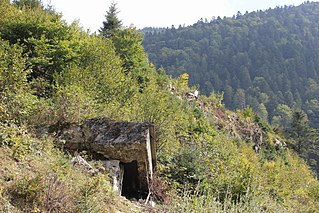
The Árpád Line was a line of fortifications built in 1941-44 in the north-eastern and eastern Carpathian Mountains, along the border of Kingdom of Hungary. It was named after Árpád, the head of the Hungarian tribes. The main function of the Line was to protect Northern Transylvania and Carpathian Ruthenia from the east.

The flexible defense is a military theory about the design of modern fortifications. The examples of "flexible" defense-lines are not based on dense lines of heavily armed, large and expensive concrete fortifications as the systems such as the Maginot Line were. Their protective capacity hinges on multiple lines of obstacles and small shelters fitting into the environment. They are "flexible" because soldiers are not locked in pillboxes, but fight instead in easily replaceable open earth-wood made positions, while bunkers serve only as shelters during bombardments. As a result, they are able to adapt to the opponent's movements, and there are no easily targeted large buildings in these lines.

Sudeten German uprising in September 1938 was a spontaneous rebellion of Sudeten Germans against Czechoslovak authorities in Sudetenland, but at the same time, an organized action orchestrated by Sudeten German Party (SdP) chaired by Konrad Henlein. Therefore, the uprising is also referred to as the Henlein's coup.



















